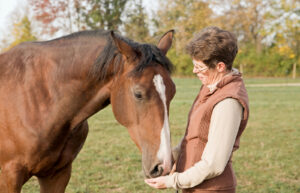Barks Blog
Observational Skills For Empathy

As Jane Goodall pointed out in an article this week, story-telling is sometimes the best way to share ideas and information. So, I thought I’d share an experience I had with a brilliant trainer utilising her empathic observation on me a few years ago.
Some years ago I acquired a rather large, 6 year old Welsh Cob (horse) who’d had very little handling. Fortunately he had the most divine temperament, but he was very big and also very scared of just about everything! Although I was confident handling and teaching him on the ground, I wasn’t so confident when I started riding him. I’m a competent rider but I wanted to make sure I got things right for him.
After I’d ‘started’ him, and had a first few rides around the paddock without problems, engaged the help of someone I knew shared my ethos; positive reinforcement, no force!
So, this lovely lady Belinda came out to teach me. On the first day she started off just watching me handling Wizard on the ground and then riding him briefly. She didn’t say anything for so long I was starting to think maybe I’d made a mistake engaging her services. Then, quite suddenly, she piped up:-
“Do you ride your older horse like that?” A bit bemused, I raised a questioning eyebrow. She grinned and then proceeded to observe various parts of my body that were holding tension. Apparently I was holding my shoulders up when I walked along next to him; I had a tendency to keep my right arm ‘tight’ and my jaw was rigid (among a long list of other things). It was all news to me (although it did shed some light on why my back was perpetually aching).
“Oh, and you need to start breathing” she added with a laugh.
Her brilliant empathic observational skills got right to the core of what the real problem was. She didn’t just observe it, she ‘read’ it, she empathised with how I was feeling (so intent on ‘getting things right’ I’d created tension) and the effect I was creating for both myself and poor Wizard. My tentative, careful approach was actually manifesting itself to Wizard as a feeling of insecurity. She didn’t correct my riding position or comment on any methodology that day. She simply read the situation and then made little observations to guide me out of this rut I had created.
What Belinda did that day was very like my role in qualitative researcher; in-depth observation and interpretation.
Sounds really easy doesn’t it – observation! I used to think that. How difficult can it be to observe stuff? When studying observational research methods, I quickly realised that it’s not as simple as it seems. When you think you’re seeing everything; you really aren’t! And, worse, you then have to try and interpret what you do see.
As a dog and horse trainer the importance of observation, really hit me when reading Frans De Waals’ “Chimpanzee Politics“. He says this about observation:
“Everyone can look, but actually perceiving is something that has to be learnt. This is a constantly recurring problem when new students arrive. For the first few weeks they ‘see’ nothing at all. When I explain to them at the end of an aggressive incident in the colony that “Yeron rushed up to Mama and slapped her, whereupon Gorilla and Mama joined forces and pursued Yeroen, who sought refuge with Nikkie”, they look at me as if I am crazy…..Whereas to me this is a superficial summary of a fairly simple interaction (only four chimpanzees were involved), the students have only seen a few black beasts chaotically charging around uttering ear-piercing screams. They will probably have missed the hard slap” (De Waal 2007: 17-18).
Marc Bekoff also raises the important point that we can sometimes observe something but interpreting ‘correctly’ (or at least as far as we know with our professional knowledge) is a whole different matter.
To be truly empathic with our canine and human students it seems vital to be acutely aware of observation skills. I’ve found some interesting and fun video links to test your observation:
https://www.youtube.com/watch?v=FWSxSQsspiQ
https://www.youtube.com/watch?v=IGQmdoK_ZfY
The point of these videos, produced by psychologists, is that they show us how easy it is to ‘see’ what we expect to see. The unusual, unexpected and inexplicable can so easily be filtered out of our conscious awareness. If you think about it, this has huge connotations to our work in dog training – are we really fully ‘seeing’ what is going on? When we miss things (like the gorilla) it is called inattentional blindness – brilliant for filtering out all the ‘white noise’ in our lives (that would otherwise drive us to distraction) but also a ‘cloaking device’ that can let us think we see everything when in fact we don’t! There’s an interesting article by Daniel Simons at this link (https://www.smithsonianmag.com/science-nature/but-did-you-see-the-gorilla-the-problem-with-inattentional-blindness-17339778/?no-ist) on how inattentional blindness can affect law and order if you’re interested in thinking about it further!
Bekoff, M. (2010) The Emotional Lives of Animals: A Leading Scientist Explores Animal Joy, Sorrow & Empathy and Why They Matter. California, New World Library.
Chabris, C. & Simons, D. ‘The Invisible Gorilla’ accessed at: https://www.theinvisiblegorilla.com/
De Waal, F. (2007). Chimpanzee politics: Power and sex among apes. Baltimore: Johns Hopkins University Press.
Goodall, J. (2015) interview accessed at: https://www.canadianbusiness.com/leadership/jane-goodall-on-branding/

